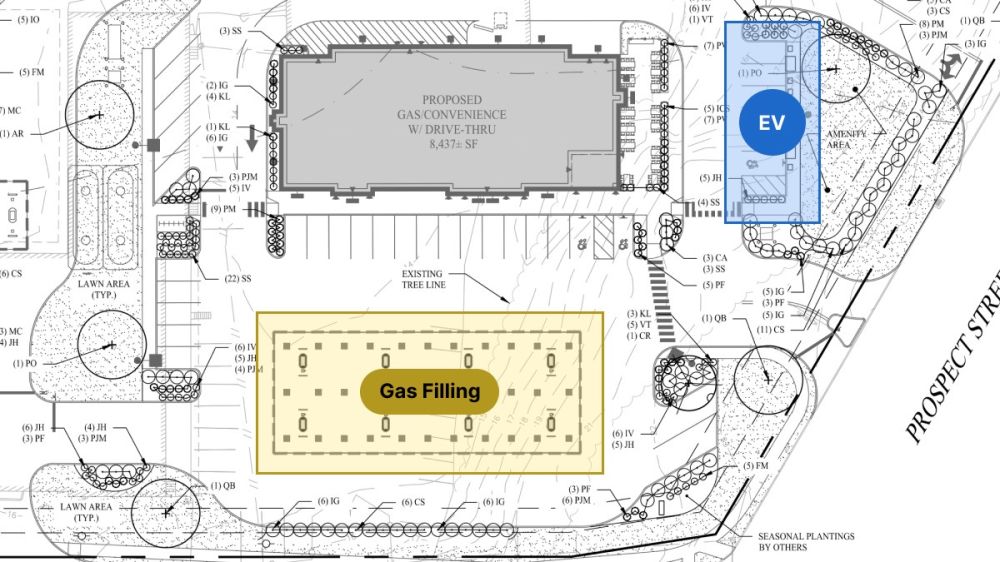Planning for Accessibility: Traffic Solutions for Multi-Use Gas and EV Sites
January 6th, 2025
As the transportation industry embraces electrification, gas station operators and land developers face a transformative opportunity. The integration of EV charging stations into traditional gas station networks is becoming a key strategy for staying competitive, meeting customer expectations, and aligning with environmental goals. Multi-use sites that combine traditional fueling options with EV infrastructure and retail amenities are not just a trend—they represent the future of roadside services. However, integrating these elements seamlessly requires a nuanced understanding of traffic flow, site layout, developer needs and user expectations. Let’s dive in!
The Business Case for Multi-Use Sites
With EV adoption accelerating due to technological advancements, regulatory incentives, and growing environmental awareness, gas stations are evolving to serve a more diverse customer base. This shift offers compelling benefits. Multi-use sites attract both traditional and EV drivers, providing a wider audience for on-site retail, food offerings and other services. The inclusion of EV chargers can also enhance brand perception as a forward-thinking and sustainable enterprise.
Still, the transition involves challenges, particularly in managing the extended dwell times associated with EV charging. Unlike traditional fueling, which takes minutes, charging can take up to an hour or more. This requires a rethinking of traditional layouts and traffic solutions to prevent congestion and ensure a smooth user experience for all customers.
Designing Sites for Traffic Efficiency and Accessibility
Creating a multi-use site that serves diverse users effectively begins with a thoughtful approach to site design. Developers must consider how vehicles and pedestrians navigate the site while optimizing efficiency and accessibility.
1. Site Layout:
EV chargers should be positioned strategically, away from high-traffic zones like gas pumps or main entryways. Placing chargers near retail areas encourages users to engage with amenities while their vehicles charge, maximizing revenue opportunities.

Above: View of site/civil drawings highlighting the separation between Gas Filling stalls and EV Charging stalls.
2. Traffic Flow:
Traffic flow is a critical aspect of multi-use site design. Entry and exit points should be clearly marked and, if possible based on the site constraints, separated for different services. For example, gas customers should have a direct route to pumps, while EV drivers can follow a distinct pathway to chargers. This minimizes cross-traffic and reduces bottlenecks.
3. Future Scalability:
As EV adoption grows, the demand for chargers will increase. Planning for future expansion by installing additional underground electrical conduits and modular infrastructure ensures the site can adapt without major overhauls.
Practical Solutions for Real-World Challenges

Above: View of new Noble Gas station in Enfield, Connecticut on opening day.
While every site has unique conditions, common solutions can address the challenges of integrating EV chargers into gas station networks:
Dwell Time Management:
Longer EV charging times can lead to parking inefficiencies. To mitigate this, developers can design dedicated EV zones that are easily accessible but do not interfere with quick turnover fueling or retail parking.
Signage and Wayfinding:
Clear, intuitive signage helps drivers locate chargers, gas pumps, and parking without confusion, reducing unnecessary delays and on-site congestion.
Technology Integration:
Partnering with EV network providers allows for smart chargers equipped with features like wait-time tracking, dynamic pricing, and real-time availability notifications via mobile apps.
Enhancing the Customer Experience
A key element of successful multi-use sites is enhancing the customer experience. With EV charging requiring longer stays, providing amenities such as retail shops, dining options, outdoor patio seating, and Wi-Fi creates an inviting environment for customers. These offerings not only improve the user experience but also generate additional revenue streams.

Above: Photo of Noble Gas EV Charging area. Photo by Solli.
Safety and accessibility are also critical. ADA-compliant chargers, well-lit pathways, and clear layouts ensure the site is inclusive and easy to navigate. Incorporating sustainable design elements, such as solar canopies, rain gardens and/or native landscaping, aligns with environmental goals while enhancing the visual appeal of the site.
Regulatory and Environmental Considerations
Navigating permitting processes and complying with environmental regulations are integral to the success of multi-use sites. Early engagement with local and state authorities can expedite approvals and ensure designs meet all requirements. Environmental considerations, such as low-impact development (LID) stormwater management systems and energy-efficient lighting, further demonstrate a commitment to sustainability while meeting regulatory standards.
Conclusion
The integration of EV infrastructure into gas stations is a vital step toward modernizing roadside services. Multi-use sites present a unique opportunity for land developers and station operators to expand their offerings, attract a broader audience, and future-proof their facilities. By prioritizing efficient traffic flow, accessible design, and enhanced customer experiences, these sites can become destinations that meet the needs of drivers today and into the future.
A well-executed multi-use gas and EV site is not only functional but also forward-thinking. It bridges the gap between traditional fueling and emerging transportation trends, setting the stage for a more sustainable and connected future. With strategic planning and a focus on adaptability, developers can lead the way in this exciting transformation of the transportation landscape.









